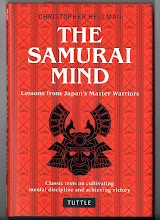 | |
| A statue of Seizan in Hirado, his sometime domain, near Nagasaki. |
This is the second of the works that I translated in The Samurai Mind, and it is one that is rather different from Neko No Myojutsu, and well worth taking a closer look at.
The Joseishi Kendan is a bit like a garage sale, but though it might be a bit messy and confusing, there's something for everyone. It consists of a host of assorted notes and mini-lectures arranged with apparent disregard for notions of order, but all of them concerned, to a lesser or greater degree, with swordsmanship.
It is not clear if Matsuura Seizan, the Joseishi of the title, wrote it himself or if it is an assembly of notes and assorted writings someone else (presumeably one of his students) put together at a later date. There is certainly evidence of some editing by someone other than Joseishi, but there is also enough written in the first person to believe that the editorial comments are later additions.
Seizan, was a man of many parts - a retired daimyo, Confucian scholar, educator, essayist, and swordsman, and about whom I have written elsewhere. It is always interesting to gain insight into people's lives and the role their arts played within them. In the world of martial arts, there seems to be a tendency to laud the biggest and the baddest, with little regard to how they lived, and how their opinions and lifestyles relate to our own. Seizan is particularly interesting because of the depth and well-roundedness of his own life, and much of this is reflected in his writing.
As an enthusiast, he was concerned with the intersection of everyday life and swordsmanship - he is surprisingly modern in his use of examples from everyday life to illustrate his points, showing how insight could be obtained from a variety of sources. Along with this is an often recurring theme - he reminds his reader that although there are secrets, they are nothing special, but rather constitute a continuatio of the practices of everyday life. Some of his examples are easy to follow, others are more abstruse, but a single thread runs through them - the importance of attention and awareness.
His interest in the commonality of a variety of phenomena is also part of Neo-Confucian teachings of the Zhu-Xi school, which stressed that 'truth' or ri, the 'principle' (of life, the universe and everything) can be discovered through wide and varied study - the opposite of Zen and Wang Yangming Confucianism, which propose finding the truth within ourselves
To give you a flavor of the way he writes, here he is talking about kyo-jitsu. This is a complex notion that includes aspects of empty-full and false-true dichotomies, but like that other famous duality, yin and yang, it doesn't equate directly with bad and good. In the account given by Ota Chuubei about Yoshioka Seijiro's death, kyo and jitsu are used to explain the dynamics of the endgame of the fight, but they can be used in other ways, too, and are also important technical terms in the teaching of bujutsu.
In the past, once I heard someone say you should think of kyo-jitsu in terms of the opening and closing of doors or sliding screens. This is because the kind of person who throws them open and slams them shut is someone who is empty inside. However fast they go in and out, someone who opens and closes them carefully is full inside, he said. Accordingly I made up my mind to follow this injunction. Beyond that, I understood little of its benefit. Having reached my last years, thinking about this I see it has increasingly become an everyday part of my swordsmanship. I put this here as something I hope people will think about.










No comments:
Post a Comment